NCERT Solutions Class 6 Maths
Chapter – 14 (Practical Geometry)
The NCERT Solutions in English Language for Class 6 Mathematics Chapter – 14 Practical Geometry Exercise 14.5 has been provided here to help the students in solving the questions from this exercise.
Chapter 14: Practical Geometry
- NCERT Solution Class 6 Maths Exercise – 14.1
- NCERT Solution Class 6 Maths Exercise – 14.2
- NCERT Solution Class 6 Maths Exercise – 14.3
- NCERT Solution Class 6 Maths Exercise – 14.4
- NCERT Solution Class 6 Maths Exercise – 14.6
Exercise – 14.5
1. Draw of length 7.3 cm and find its axis of symmetry.
Solutions:
Following steps are followed to construct of length 7.3 cm and to find its axis of symmetry.
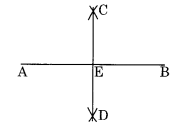
Step 1: Draw = 7.3 cm.
Step 2: Taking A and B as centre and radius more than half of , draw two arcs which intersect each other at C and D.
Step 3: Join C and D to intersect at E. Thus, CD is the perpendicular bisector or axis of symmetry of
.
2. Draw a line segment of length 9.5 cm and construct its perpendicular bisector.
Solutions:
Following steps are observed to construct a line segment of length 9.5 cm and to construct its perpendicular bisector.
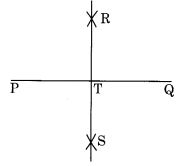
Step 1: Draw a line segment =9.5 cm.
Step 2: With centres P and Q and radius more than half of PQ, draw two arcs which meet each other at R and S.
Step 3: Join R and S to meet at T.
Thus, RS is the perpendicular bisector of .
3. Draw the perpendicular bisector of whose length is 10.3 cm.
(a) Take any point P on the bisector drawn. Examine whether PX = PY.
(b) If M is the mid point of , what can you say about the lengths MX and XY?
Solutions:
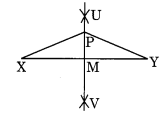
Step 1: Draw a line segment = 10.3 cm.
Step 2: With centre X and Y and radius more than half of XY, draw two arcs which meet each other at U and V.
Step 3: Join U and V which meets at M.
Step 4: Take a point P on .
(a) On measuring, PX = PY = 5.6 cm.
(b) On measuring, =
=
XY = 5.15 cm.
4. Draw a line segment of length 12.8 cm. Using compasses, divide it into four equal parts. Verify by actual measurement.
Solutions:
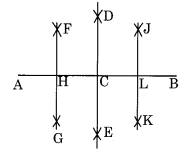
Step 1: Draw a line segment = 12.8 cm
Step 2: With centre A and B and radius more than half of AB, draw two arcs which meet each other at D and E.
Step 3: Join D and E which meets at C which is the midpoint of
.
Step 4: With centre A and C and radius more than half of AC, draw two arcs which meet each other at F and G.
Step 5: Join F and G which meets at H which is the midpoint of
.
Step 6: With centre C and B and radius more than half of CB, draw two arcs which meet each other at J and K.
Step 7: Join J and K which meets at L which is the midpoint of
.
Thus, on measuring, we find
=
=
=
= 3.2 cm.
5. With of length 6.1 cm as diameter, draw a circle.
Solutions:
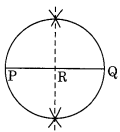
Step 1: = 6.1 cm
Step 2: Draw a perpendicular bisector of which meets
at R i.e. R is the midpoint of
.
Step 3: With centre R and radius equal to , draw a circle passing through P and Q.
Thus, the circle with diameter = 6.1 cm is the required circle.
6. Draw a circle with centre C and radius 3.4 cm. Draw any chord . Construct the perpendicular bisector of
and examine if it passes through C.
Solutions:
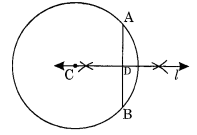
Step 1: Draw a circle with centre C and radius 3.4 cm.
Step 2: Draw any chord .
Step 3: Draw the perpendicular bisector of which passes through the centre C.
7. Repeat Question 6, if happens to be a diameter.
Solutions:
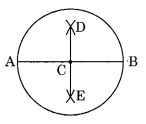
Step 1: Draw a circle with centre C and radius 3.4 cm.
Step 2: Draw a diameter AB of the circle.
Step 3: Draw a perpendicular bisector of AB which passes through the centre C and on measuring, we find that C is the midpoint of .
8. Draw a circle of radius 4 cm. Draw any two of its chords. Construct the perpendicular bisectors of these chords. Where do they meet?
Solutions:
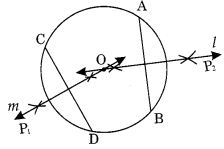
Step 1: Draw a circle with centre 0 and radius 4 cm.
Step 2: Draw any two chords and
of the circle.
Step 3: Draw the perpendicular bisectors of and
i.e. I and m.
Step 4: On producing the two perpendicular bisectors meet each other at the centre O of the circle.
9. Draw any angle with vertex O. Take a point A on one of its arms and B on another such that OA = OB. Draw the perpendicular bisectors of and
. Let them meet at P. Is PA = PB?
Solutions:
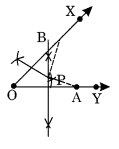
Step 1: Draw an angle XOY with O as its vertex.
Step 2: Take any point A on OY and B on OX, such that OA + OB.
Step 3: Draw the perpendicular bisectors of OA and OB which meet each other at a point P.
Step 4: Measure the lengths of and
. Yes,
=
.

